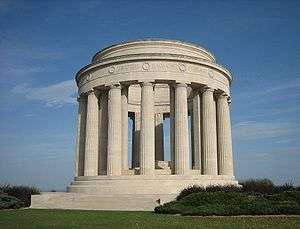Montsec, Meuse
| Montsec | |
|---|---|
| Commune | |
 | |
 Montsec | |
|
Location within Grand Est region  Montsec | |
| Coordinates: 48°53′29″N 5°43′16″E / 48.8914°N 5.7211°ECoordinates: 48°53′29″N 5°43′16″E / 48.8914°N 5.7211°E | |
| Country | France |
| Region | Grand Est |
| Department | Meuse |
| Arrondissement | Arrondissement of Commercy |
| Canton | Canton of Saint-Mihiel |
| Intercommunality | Communauté de communes de la Petite Woëvre |
| Government | |
| • Mayor (2008–2014) | Daniel Lombard |
| Area1 | 5.95 km2 (2.30 sq mi) |
| Population (1999)2 | 68 |
| • Density | 11/km2 (30/sq mi) |
| Time zone | CET (UTC+1) |
| • Summer (DST) | CEST (UTC+2) |
| INSEE/Postal code | 55353 /55300 |
| Elevation |
226–376 m (741–1,234 ft) (avg. 370 m or 1,210 ft) |
|
1 French Land Register data, which excludes lakes, ponds, glaciers > 1 km² (0.386 sq mi or 247 acres) and river estuaries. 2 Population without double counting: residents of multiple communes (e.g., students and military personnel) only counted once. | |
Montsec is a commune in the Meuse department in Grand Est in north-eastern France. Fighting in World War I and World War II took place in and around Montsec. The Montsec American Monument was built here during the 1930s by the American Battle Monuments Commission. The monument, dedicated in 1937, commemorates the American forces who fought in the Battle of Saint-Mihiel in World War I.
History
During The Great War, also known as World War I, the village was occupied by the Germans in 1914 during the Battle of Flirey.[1] A hill, sharing the same name, commands a view of the Woëvre Plain, and was used by German forces as a strong point and for observation.[2]
During the Battle of Saint-Mihiel in 1918, 1st Division attacked in the area of Montsec, bypassing it.[3] The 1st Division was joined by the 26th Division, attacking on the other side of Montsec, also bypassing it.[4] Both the 1st and 26th Divisions were able to accomplish it by a smoke screen being placed on the hill.[5]
Having been bypassed due to it being fortified, being cut off from the rest of the German line, it fell to the Allies.[2] This was accomplished by forces of the French 2nd Colonial Corps.[6]
Before the Battle of Nancy, the commune was liberated by the American 317th Infantry in 1944.[7]
Montsec American Monument

The monument was designed by Egerton Swartwout, and has been described as a doric temple.[8] It was built during the 1930s by the American Battle Monuments Commission;[9] it was dedicated in 1937.[10] The monument commemorates American forces involved in the Battle of Saint-Mihiel.[11] These included the First and Second armies.[12]
During World War II, German forces occupying France left the monument untouched.[13] As American forces advanced, and began to displace the Germans, the memorial was damaged by American artillery.[14] The monument was later restored.[14]
It has been described as being similar to the Jefferson Memorial.[15]
See also
- Communes of the Meuse department
- List of World War I memorials and cemeteries in the area of the St Mihiel salient
- Parc naturel régional de Lorraine
References
- ↑ Richard Rubin (21 May 2013). The Last of the Doughboys: The Forgotten Generation and Their Forgotten World War. Houghton Mifflin Harcourt. p. 321. ISBN 0-547-84369-0.
- 1 2 Frank Herbert Simmonds (1920). History of the world war. Published for the Review of reviews company by Doubleday, Page & company. pp. 223–224.
- ↑ Richard Joseph Beamish; Francis Andrew March (1919). America's Part in the World War: A History of the Full Greatness of Our Country's Achievements; the Record of the Mobilization and Triumph of the Military, Naval, Industrial and Civilian Resources of the United States. John C. Winston Company. p. 554.
- ↑ John Eisenhower (14 September 2001). Yanks: The Epic Story of the American Army in World War I. Simon and Schuster. p. 193. ISBN 978-0-7432-1637-1.
- ↑ Walter Hines Page; Arthur Wilson Page (1919). The World's Work. Doubleday, Page & Company. p. 82.
- ↑ James Alfred Moss; Harry Samuel Howland (1920). America in Battle: With Guide to the American Battlefields in France and Belgium. Geo. Banta Publishing Company. p. 168.
- ↑ Dominique, Dean James (August 2003). "Chapter 3: The Moselle River Bridgehead August 23 – November 1, 1944". The Attack Will Go On: The 317th Infantry Regiment in World War II (PDF) (Masters). Louisiana State University. p. 30-31. Retrieved 25 May 2015.
- ↑ Ron Theodore Robin (14 July 2014). Enclaves of America: The Rhetoric of American Political Architecture Abroad, 1900–1965. Princeton University Press. pp. 50–51. ISBN 978-1-4008-6310-5.
- ↑ Intelligence and Security Command Journal. U.S. Army Intelligence and Security Command. 1984. p. 4.
- ↑ Montsec American Monument Dedication in 1937. ABMCVIDEOS. 13 June 2015 [1937]. Retrieved 25 May 2015.
- ↑ David Bonk (20 October 2011). St Mihiel 1918: The American Expeditionary Forces' trial by fire. Osprey Publishing. p. 93. ISBN 978-1-84908-880-0.
- ↑ "Montsec Monument" (PDF). American Battle Monuments Commission. 21 April 2014. Retrieved 25 May 2015.
- ↑ Douglas Peter Mackaman Michael Mays. World War I and the Cultures of Modernity. Univ. Press of Mississippi. p. 158. ISBN 978-1-60473-712-7.
- 1 2 Rubin, Richard (18 September 2014). "In France, Artifacts of America’s Role in World War I". New York Times. Retrieved 25 May 2015.
- ↑ Julia Hargrove (1 March 2003). Tomb of the Unknowns (ENHANCED eBook). Lorenz Educational Press. p. 14. ISBN 978-1-4291-1258-1.
J. D. Ragsdale (25 March 2014). Beyond Buildings: Designed Spaces as Visual Persuasion. Cambridge Scholars Publishing. p. 121. ISBN 978-1-4438-5838-0.
| Wikimedia Commons has media related to Montsec (Meuse). |